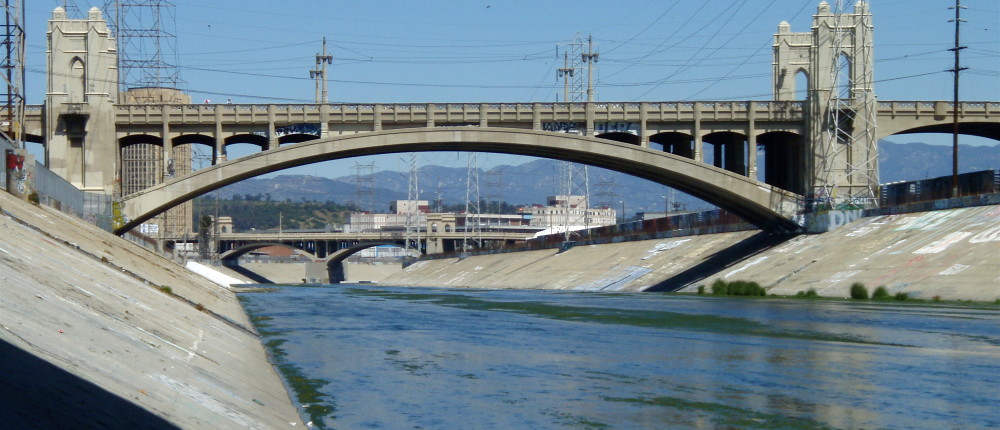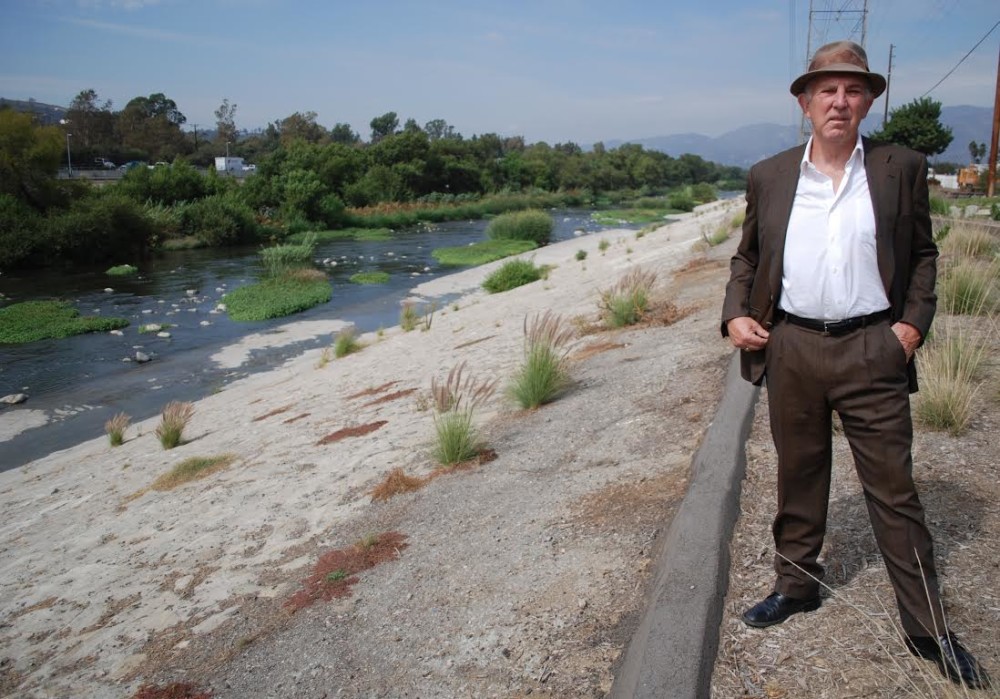05 Feb Lewis MacAdams on the LA River, Frank Gehry, and the Return of the Red Legged Frog

When the announcement trickled out in August that Frank Gehry would take over master planning duties for the L.A. River, it caught some locals by surprise. Perhaps no one was more startled—and more critical—about this seeming mismatch than Lewis MacAdams, the co-founder and president of Friends of the L.A. River(FoLAR), an organization that has been working on behalf of the 52-mile long urban river for three decades.
MacAdams co-founded FoLAR in 1985, just two years arriving in Los Angeles. He is a kind of citizens planner and activist: part poet (literally, he’s published 12 collections) and part politician. For him, the politics and the poetics of the river are inexplicably linked. Recently I spoke with MacAdams about the Gehry brouhaha, FoLAR’s new research initiative, the (slowly) evolving Army Corps of Engineers, and the return of the red legged frog.
MCP:You were one of the few people to publicly criticize Frank Gehry’s involvement in the L.A. River. There were a number of critics who expressed what I would call respectful skepticism, but in many articles you were often the lone voice of vocal opposition. In the four months since, have you softened your stance?

LMA:The Gehry thing was pretty overblown. We were sort of backed into a corner, when it wasn’t really our issue. FoLAR is about community building, science, and education. We run this thing called the Frog Spot, which is a Saturday/Sunday outdoor cafe on the river. We also have the River Rover, which is our mobile classroom that primarily goes to schools. We just started working with the Aquarium of the Pacific in Long Beach, on a study of the river. I’ve never met Frank Gehry. The issues here have been complicated because of our relationship with the L.A. River Revitalization Corporation, which is who asked Gehry to become involved. We feel that the River Revitalization Corporation can and should do what they want. They’ve got some maps and drawings and architectural renderings, but it doesn’t relate so directly to what we’re doing.
MCP:Does that make you hopeful or uneasy?
LMA:Basically, I would remind them that the last time there was a single idea for the entire river it involved 17,000 people pouring three million barrels of concrete. The idea of one person being in charge of design for a 52 mile long urban river seems kind of absurd on the face of it. They may have some different plans that we’re not privy to. In fact I assume that they do. We were supposed to meet Gehry but then he had back surgery and we never met him. So we haven’t got a chance to talk to him yet. I feel like that’s a missing piece here, figuring out exactly what he’s interested in.
MCP:I remember reading the news and thinking: these guys have been at this for a quarter century, and now the mayor comes in and picks the most famous architect in the world? For a river that was getting planned organically, from the ground up, it seemed like a tone deaf move. To Gehry’s credit, he talked about hydrology, he’s formed an international team of water experts, he’s made the right sounds initially. Still, the move on Mayor Garcetti’s part made it look like he didn’t know the players, didn’t know the recent history of grassroots involvement, or any of the specifics on the ground.
LMA:I don’t think Garcetti was central to the selection of Gehry. I haven’t talked to him about it, but I think it was brought to him by the River Revitalization Corporation. They have a guy named Jordan Kerner, a movie and television producer who’s very well connected and on their board. I believe Jordan put the connection together. I’m guessing the mayor wasn’t there in the formative moments of it. I have no problem with Gehry. Whether he’s thinking the right thoughts, good or bad thoughts, it’s just not organically what FoLAR is all about. We’re in the process of putting together a research project determining how much water the river needs. We’re focussing a lot of our brain power on that.
MCP:Who’s conducting that research for you?
LMA:We have three people that are working at FoLAR. They’re all young and ambitious. It’s a kind of an activist think tank. In the months to come, we’ll start issuing findings. The question—how much water does the river need?—can be looked at as the question for the whole river. It’s central to what we’ll be doing over the next year, rather than fret about Frank Gehry. It touches on all the issues, in terms of hydraulics, economics, culture, spiritual growth, the whole realm of things. There are a lot of questions to look at: is the L.A. River a natural river? If it were truly a natural river, it would only have water during the rainy season. But we have all this recycled water, which may end up being all the water we get. No one can truly predict that. The role of the river, how it maintains and encourages the ecology of the region, are fundamental questions that are only now beginning to be asked.
The question–how much water does the river need–can be looked at as the central question for the whole river.
There’s a feeling among some people that: the grassroots folks have been working on this forever and now the big boys are moving in. I don’t see it that way. I see it evolving in a much more interesting way. The longer this project goes along, the less uniform it’s going to be. And FoLAR, I guarantee you, will be in the center of the mix.
MCP:Has your research team reached out to the Gehry office in hopes of a collaboration?
LMA:We recently reached out, but haven’t heard back from them. There’s a lot of complex politics being played out. And a lot of it is not on the surface. So it’s a difficult question to answer directly.
MCP:Your group has done impressive grassroots work, but when the big plans and big players grind into motion, when the Army Corps of Engineers gets its one or two billion needed to make its moves, what’s your role then?
LMA:In terms of the Army Corps of Engineers, we’re already involved. The corps ran out of money to finish the arbor study and we raised a million dollars so that they could finish it. The funds that we raised are the only money that’s changed hands so far, so we’re already central players. In Washington, when the deal was created to accept this arbor study, which will take out eleven miles of concrete and restore about eleven miles of habitat, one of the people celebrating with us was Thomas Bostick, the lieutenant general in charge of the corps of engineers.
MCP:It’s interesting. For decades, the corps was widely reviled by environmentalists. But I’ve talked to a few people who insist that they have improved, become a bit more farsighted. Has that been your experience?
LMA:Yes. It has to do with individuals. The corps rotates people in and out, so it’s hard to get a commitment from them involving long periods of time. That’s why I set this up as a forty year art work. I figured it had taken them forty years to screw the river up, they could then have jobs for the next forty fixing what they’d got wrong the first time. One of the things I’ve learned, though, in recent experience—and I’m an old-time Corps hater—is that people and even institutions can change. I see restoring the river as something like building a subway system. It’s an infrastructural move. I think of myself as more of an infrastructuralist than an environmentalist.
MCP:Where do you want to see the river go in the next five or ten years? It seems like it’s reached an important moment when things can move faster.
LMA:I see, sooner rather than later, the beginnings of taking out concrete. That’s without a doubt what I’d like to see while I’m still able to see. To see concrete being pulled out of the river. The ultimate goal is the return of the steelhead trout. People laugh at that. But a bald eagle was spotted in the Sepulveda Basin, in the middle of the San Fernando Valley, a couple weeks ago. One of the things that we do at the Frog Spot is ask: what happened to the red legged frog? There was once extremely large numbers of them around. They hibernated in the mud underneath the river. The river was channelized and concretized and so there was no place for them to hibernate. We’re now asking for forgiveness. So that the red legged frog can hibernate beneath the river for the first time in 75 years.

